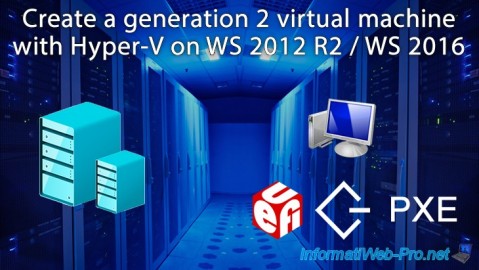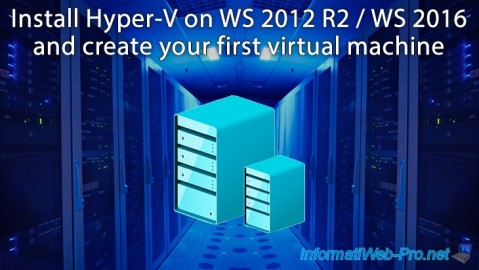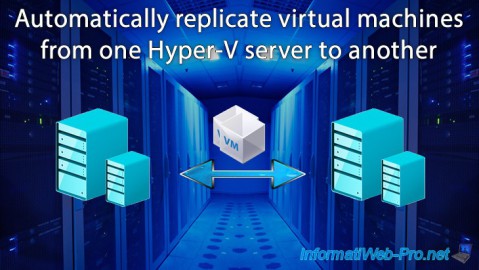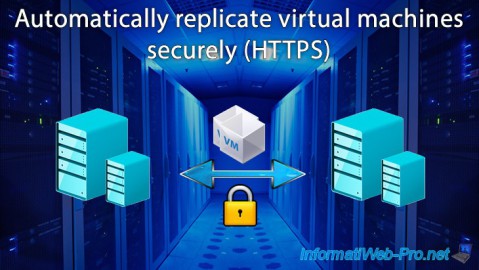Create a Hyper-V 3.0 failover cluster on WS 2012 R2 or WS 2016
- Microsoft
- 29 November 2019 at 10:34 UTC
-

- 5/6
4. Add an existing virtual machine to your Hyper-V cluster
4.1. Moving storage
As you can see, we have 4 virtual machines on our Hyper-V server, but only one is part of our cluster.
The other 3 virtual machines are hosted locally on this Hyper-V server and they don't benefit from the high availability offered by our cluster.
However, to add them to the cluster, it's also necessary that their storage (configuration files, virtual hard disks, snapshots, ...) be accessible from any node of the cluster.
However, these are currently stored on the local hard drive of our Hyper-V server.
To get started, select the virtual machine that you want to add to your cluster and click Settings.

As you can see, this computer is stored locally on our Hyper-V server.

To solve this problem, we will first have to move their storage to the shared volume of our cluster.
To do this, right-click on the virtual machine you want to move the storage and click Move.

Select : Move the virtual machine's storage.
Indeed, in this case, we only want to move the storage of this virtual machine and not its execution.

Select : Move all of the virtual machine's data to a single location.

Click Browse.

Select your cluster shared volume or one of its subfolders.
In our case, we selected this folder "C:\ClusterStorage\volume1".

Click Next.

A summary is displayed.

Wait while moving the storage of this virtual machine.

As you can see in the Hyper-V Manager, moving the storage is in progress.

Once the move is complete, the status will disappear.

If you go into the settings of this virtual machine, you will see that its virtual hard disk has also been moved to the shared volume of your cluster "C:\ClusterStorage\volume1\Virtual Hard Disks\...".

4.2. Add the virtual machine to the cluster
Now that the virtual machine is stored on the shared volume of your cluster, you must add it to your cluster for automatic failover.
For the moment, your cluster is not aware of this virtual machine and the high availability of this virtual machine is not yet available.
Previously, to create a virtual machine in our cluster, we went through the "Roles -> Virtual Machines -> New Virtual Machine" menu.
However, since our virtual machine already exists on our Hyper-V server and we only want to add it to the cluster, we will not be able to use this option.
In this case, you will need to right-click Roles, and then click : Configure Role.

The High Availability Wizard appears.

Select : Virtual Machine.

The list of virtual machines of your Hyper-V servers that are not yet in your cluster appears.
Nevertheless, note that we can only add our "Win 7 x64" virtual machine for the moment, because it's the only one that is currently stored on the shared volume of our cluster.
So we check the "Win 7 x64" box.

Click Next.

The wizard configures high availability for the previously selected virtual machine.

A summary is displayed.

Our virtual machine that was hosted locally on our Hyper-V server is now part of our cluster.

If you go back to the Hyper-V Manager of your Hyper-V server, you will see that this virtual machine is now clustered.

Share this tutorial
To see also
-

Microsoft 9/6/2019
Hyper-V (WS 2012 R2 / 2016) - Create a generation 2 VM
-

Microsoft 8/10/2019
Hyper-V (WS 2012 R2 / 2016) - Install Hyper-V and create your first VM
-

Microsoft 11/8/2019
Hyper-V (WS 2012 R2 / WS 2016) - Automatically replicate virtual machines
-

Microsoft 11/15/2019
Hyper-V (WS 2012 R2 / WS 2016) - Automatically replicate virtual machines (securely)

No comment